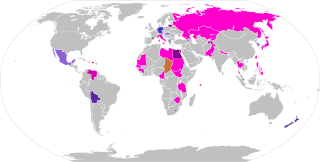Parallel voting is a type of mixed electoral system in which representatives are voted into a single chamber using two or more different systems, most often first-past-the-post voting (FPTP) with party-list proportional representation (PR). It is the most common form of mixed member majoritarian representation (MMM), which is why these terms are often used synonymously with each other. In some countries, parallel voting is known as the supplementary member (SM) system, while in academic literature it is sometimes called the superposition method within mixed systems.

The 1987 Italian general election was held in Italy on 14–15 June 1987. This election was the first Italian election in which the distance between the Christian Democrats and the Communists grew significantly instead of decreasing. Two parties that had not previously been in parliament won representation: the Greens with thirteen seats, and the Northern League with two.

The politics of Lombardy, a region of Italy, takes place in a framework of a semi-presidential representative democracy, whereby the President of the Region is the head of government, and of a pluriform multi-party system. Legislative power is vested in the Regional Council of Lombardy, while executive power is exercised by the Regional Government led by the President, who is directly elected by the people. The current Statute, which regulates the functioning of the regional institutions, has been in force since 2008.

The 1995 Lombard regional election took place on 23 April 1995. The 6th term of the Regional Council was chosen.

The 2010 Lombard regional election took place on 28–29 March 2010. The 9th term of the Regional Council was chosen.

Lombardy elected its second delegation to the Italian Senate on June 7, 1953. This election was a part of national Italian general election of 1953 even if, according to the Italian Constitution, every senatorial challenge in each Region is a single and independent race.

Lombardy elected its third delegation to the Italian Senate on May 25, 1958. This election was a part of national Italian general election of 1958 even if, according to the Italian Constitution, every senatorial challenge in each Region is a single and independent race.

Lombardy elected its forth delegation to the Italian Senate on April 28, 1963. This election was a part of national Italian general election of 1963 even if, according to the Italian Constitution, every senatorial challenge in each Region is a single and independent race.

A mixed electoral system or mixed-member electoral system combines methods of majoritarian and proportional representation (PR). The majoritarian component is usually first-past-the-post voting (FPTP/SMP), whereas the proportional component is most often based on party-list PR. The results of the combination may be mixed-member proportional (MMP), where the overall results of the elections are proportional, or mixed-member majoritarian, in which case the overall results are semi-proportional, retaining disproportionalities from the majoritarian component.

Lombardy elected its fifth delegation to the Italian Senate on May 19, 1968. This election was a part of the national Italian general election of 1968 even if, according to the Italian Constitution, every senatorial challenge in each Region is a single and independent race.

Lombardy elected its sixth delegation to the Italian Senate on May 19, 1972. This election was a part of national Italian general election of 1972 even if, according to the Italian Constitution, every senatorial challenge in each Region is a single and independent race.

Lombardy elected its seventh delegation to the Italian Senate on June 20, 1976. This election was a part of national Italian general election of 1976 even if, according to the Italian Constitution, every senatorial challenge in each Region is a single and independent race.

Lombardy elected its eighth delegation to the Italian Senate on June 3, 1979. This election was a part of national Italian general election of 1979 even if, according to the Italian Constitution, every senatorial challenge in each Region is a single and independent race.

Lombardy elected its ninth delegation to the Italian Senate on June 26, 1983. This election was a part of national Italian general election of 1983 even if, according to the Italian Constitution, every senatorial challenge in each Region is a single and independent race.

Lombardy elected its tenth delegation to the Italian Senate on June 14, 1987. This election was a part of national Italian general election of 1987 even if, according to the Italian Constitution, every senatorial challenge in each Region is a single and independent race.

Lombardy elected its eleventh delegation to the Italian Senate on April 5, 1992. This election was a part of national Italian general election of 1992 even if, according to the Italian Constitution, every senatorial challenge in each Region is a single and independent race.

Lombardy renewed its delegation to the Italian Senate on March 27, 1994. This election was a part of national Italian general election of 1994 even if, according to the Italian Constitution, every senatorial challenge in each Region is a single and independent race.
Democratic elections have been held in Naples, Italy, since the collapse of Benito Mussolini's fascist regime. Today, all residents of Naples who are at least 18 years old and hold an EU citizenship are eligible to vote for the mayor and the 48 members of the city council. They also vote for the president and the 30 or 40 members of the municipal council in which they reside.
Mixed-member majoritarian representation (MMM) is type of a mixed electoral system combining winner-take-all and proportional methods, where the disproportional results of the winner-take-all part are dominant over the proportional component. Mixed member majoritarian systems are therefore categorized under semi-proportional representation, and are usually contrasted with mixed-member proportional representation (MMP) which aims to provide proportional representation compensation ("top-up") seats.
The next Italian general election will occur no later than 22 December 2027, although it may be called earlier as a snap election.















